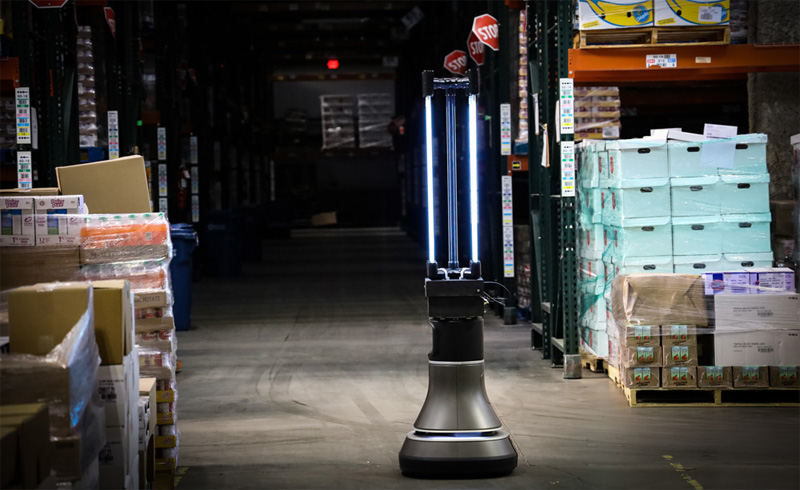
Researchers at MIT's Computer Science and Artificial Intelligence Laboratory (CSAIL), in collaboration with Ava Robotics and the Greater Boston Food Bank (GBFB), have designed a new robotic system that kills microorganisms in its proximity, using ultraviolet light.
During tests at GBFB, the robot drove by pallets and storage aisles at 0.22 miles per hour. At this speed, the robot could cover a 4,000-square-foot warehouse space in just half an hour. Ultraviolet C (UV-C) is a subtype of ultraviolet light that is short-wavelength (100–280 nm) and germicidal. Its light can kill or inactivate microorganisms by destroying nucleic acids and disrupting DNA or RNA. The dosage emitted by the robot seen here neutralised 90% of coronaviruses (and other organisms) on the warehouse surfaces. The results are encouraging enough that the approach could be useful for autonomous UV disinfection in other environments – such as airplanes, factories, restaurants, schools, and supermarkets, according to the researchers. Since UV-C is dangerous for all living organisms, however, it can only operate when nobody is around. MIT designed the UV-C light fixture, which then became integrated with Ava Robotics' mobile robot base. The complete system can map a space and navigate between waypoints and other pre-specified areas. While most effective in the direct "line of sight," the machine can get to nooks and crannies as the light bounces off surfaces. "Our 10-year-old warehouse is a relatively new food distribution facility with AIB-certified, state-of-the-art cleanliness and food safety standards," explained Catherine D'Amato, President of the Greater Boston Food Bank. "COVID-19 is a new pathogen that GBFB, and the rest of the world, was not designed to handle. We are pleased to have this opportunity to work with MIT CSAIL and Ava Robotics to innovate and advance our sanitation techniques to defeat this menace." Food banks are facing a particular demand due to the stress of COVID-19. The United Nations estimates that, because of the virus, the number of people facing severe food insecurity worldwide could double to 265 million. In the U.S. alone, the five-week total of job losses has risen to 26 million, potentially pushing millions more into food insecurity. "Food banks provide an essential service to our communities, so it is critical to help keep these operations running," said Alyssa Pierson, CSAIL research scientist and technical lead of the UV-C lamp assembly. "Here, there was a unique opportunity to provide additional disinfecting power to their current workflow and help reduce the risks of COVID-19
exposure."A shipping area can change overnight, so the team is now researching how to use onboard sensors to adapt to new environments – teaching the robot to differentiate between occupied and unoccupied aisles, for example, so it can switch its path accordingly; and altering its speed to ensure the optimal UV dosage is applied to different objects and surfaces. Comments »Source: https://www.futuretimeline.net

